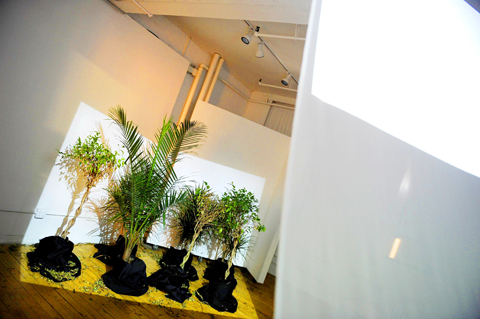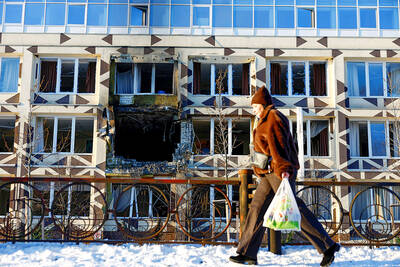From Avatar to Lord of the Rings, plants are no strangers to playing big movie roles, but no one’s ever shot a film the plants themselves can watch. Until now.
In a New York art gallery, seven house plants have spent the last seven weeks watching Strange Skies, Travel Documentaries for Plants probably the first travel documentary for a vegetable audience.
The movie by conceptual artist Jonathon Keats consists of idyllic Italian skies recorded over a two-month period and condensed into a six-minute dawn-to-dawn span.

PHOTO: AFP
Sitting attentively in cinema-like rows — a majesty palm partially blocking the view of rubber plants behind — the potted audience basks in an electric version of Italian sunshine.
Keats — who previously used footage of bees pollinating flowers to make pornography for plants — said an aspiring filmmaker couldn’t compete with the likes of Avatar director James Cameron.
“But then I realized there’s a much larger audience — there are many more plants than people — that were not being serviced,” he said. “I wanted basically to provide plants with what companies such as Disney or MGM provide humans.”
In the film, projected onto a fluttering white cloth, clear dawn gives way to high cirrus, the occasional airplane trail, a fleeting cameo fly-by of a bird, then dusk.
At night, beams from a romantic quarter moon hit the trunk of one of the ficus trees.
The movie has no sound and the plants, of course, do not applaud.
Other than an alarming loss of leaves among the ficuses there is no discernible reaction.
However, Stephen Squibb, a fellow at the AC Institute, which hosted the installation in a Chelsea gallery, said these viewers were unusually riveted: photosynthesis, or the process of turning light into energy, means the movie keeps them alive.
“This is how they eat,” Squibb said.
The New York natives even get a taste of Italy.
“They’re literally changing their diet,” he said.
Keats sees lessons for visiting humans, who can survey the scene from two minimalist white benches.
“Clearly this is an imperfect representation of place and that’s for me part of what the work deals with. How do we experience the world and how reliable is it?” he asked. “So much of the world we get on screens. By watching the plants watching the sky, there’s something a bit sad and sordid.”
One visitor, artist Rob Tarbell, enjoyed seeing plants center stage.
“It’s good to see a respectful inclusion of something live, capitalizing on what they benefit from rather than having any aspect of cruelty or a freak show,” Tarbell said.
Another visitor, photographer Abbas Ebrahimi, also expressed admiration for the green audience.
“Plants are better than us. We die and go, while in spring they come back each time,” he said.
But after contemplating the installation for a few minutes, he declared: “It doesn’t mean anything to me at all. It’s just trees and light.”
“For some people it might mean something. Maybe if they smoke grass,” he said.
Keats, currently doing a residency at upstate New York’s Yaddo artist colony, is intent on furthering his exploration of plant sensibilities. He plans a “restaurant for plants” at a California museum.
Before that, he’s turning to another overlooked population — bacteria.
He hopes to create educational textbooks teaching general relativity and quantum mechanics to the microorganisms in “easy-to-digest doses of amino acid and glucose.”
“I figure these books should be beneficial to both microbes and humans: By providing bacteria with a good education, we’ll be able to improve their quality of life, and to discourage them from becoming pathogens,” he said.

Indonesia yesterday began enforcing its newly ratified penal code, replacing a Dutch-era criminal law that had governed the country for more than 80 years and marking a major shift in its legal landscape. Since proclaiming independence in 1945, the Southeast Asian country had continued to operate under a colonial framework widely criticized as outdated and misaligned with Indonesia’s social values. Efforts to revise the code stalled for decades as lawmakers debated how to balance human rights, religious norms and local traditions in the world’s most populous Muslim-majority nation. The 345-page Indonesian Penal Code, known as the KUHP, was passed in 2022. It

‘DISRESPECTFUL’: Katie Miller, the wife of Trump’s most influential adviser, drew ire by posting an image of Greenland in the colors of the US flag, captioning it ‘SOON’ US President Donald Trump on Sunday doubled down on his claim that Greenland should become part of the US, despite calls by the Danish prime minister to stop “threatening” the territory. Washington’s military intervention in Venezuela has reignited fears for Greenland, which Trump has repeatedly said he wants to annex, given its strategic location in the arctic. While aboard Air Force One en route to Washington, Trump reiterated the goal. “We need Greenland from the standpoint of national security, and Denmark is not going to be able to do it,” he said in response to a reporter’s question. “We’ll worry about Greenland in

PERILOUS JOURNEY: Over just a matter of days last month, about 1,600 Afghans who were at risk of perishing due to the cold weather were rescued in the mountains Habibullah set off from his home in western Afghanistan determined to find work in Iran, only for the 15-year-old to freeze to death while walking across the mountainous frontier. “He was forced to go, to bring food for the family,” his mother, Mah Jan, said at her mud home in Ghunjan village. “We have no food to eat, we have no clothes to wear. The house in which I live has no electricity, no water. I have no proper window, nothing to burn for heating,” she added, clutching a photograph of her son. Habibullah was one of at least 18 migrants who died

Russia early yesterday bombarded Ukraine, killing two people in the Kyiv region, authorities said on the eve of a diplomatic summit in France. A nationwide siren was issued just after midnight, while Ukraine’s military said air defenses were operating in several places. In the capital, a private medical facility caught fire as a result of the Russian strikes, killing one person and wounding three others, the State Emergency Service of Kyiv said. It released images of rescuers removing people on stretchers from a gutted building. Another pre-dawn attack on the neighboring city of Fastiv killed one man in his 70s, Kyiv Governor Mykola